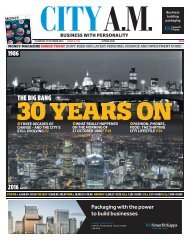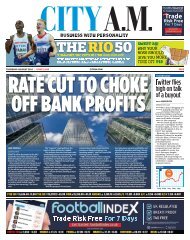You also want an ePaper? Increase the reach of your titles
YUMPU automatically turns print PDFs into web optimized ePapers that Google loves.
24 FEATURE TUESDAY 4 APRIL 2017<br />
CITYAM.COM<br />
TRADING AND INVESTMENT<br />
WHERE NEXT<br />
FOR EMERGING<br />
MARKET DEBT?<br />
EMERGING market debt (EMD)<br />
has matured as an asset<br />
class, with a growing<br />
number of investors<br />
attracted to the increasingly<br />
positive economic fundamentals and<br />
higher yields.<br />
EMD also offers an expanding<br />
opportunity set with plenty of diversification<br />
opportunities. That said,<br />
the asset class comes with distinct<br />
risks that makes achieving relatively<br />
stable returns in the shorter term no<br />
easy task. The answer, we believe,<br />
involves a different approach to asset<br />
allocation and selection, and access<br />
to the right technology to undertake<br />
risk management in real time.<br />
MOVING BEYOND THE<br />
TRADITIONAL<br />
Traditional fundamental top-down<br />
and bottom-up active management<br />
approaches can be inadequate during<br />
regime changes or when unexpected<br />
events roil markets. It is therefore not<br />
enough to implement a static asset<br />
allocation between local, hard and<br />
corporate debt based on historical<br />
data and to then try to achieve optimum<br />
timing.<br />
To take fuller advantage of the asset<br />
class, a more forward-looking investment<br />
approach that takes into<br />
account EMD’s distinct<br />
characteristics is required, even more<br />
so now. Performance drivers have<br />
become more numerous and complex,<br />
just as the investment environment<br />
in fixed income is increasingly<br />
challenging following a 35-year bull<br />
market. Central bank support is now<br />
BlackRock’s<br />
Sergio Trigo Paz<br />
examines the<br />
opportunity<br />
presented by this<br />
maturing asset<br />
class<br />
Emerging market<br />
debt has had a<br />
strong start so far<br />
this year. Hard<br />
currency<br />
sovereign debt<br />
returned 3.38 per<br />
cent and local debt<br />
is up 4.62 per cent<br />
in US dollar terms<br />
waning and investors may be left<br />
over-exposed to monetary policy<br />
risks.<br />
This suggests that further diversification<br />
away from core developed<br />
market fixed income is set to be crucial.<br />
In this context, EMD stands out<br />
as one of the few remaining places<br />
where investors can find investmentgrade<br />
yield that offers some protection<br />
against the impact of rising<br />
interest rates. So despite perceived<br />
headwinds following Donald<br />
Trump’s victory in November 2016,<br />
EMD has had a strong start so far this<br />
year. Hard currency sovereign debt<br />
returned 3.38 per cent and local debt<br />
is up 4.62 per cent in US-dollar terms<br />
as of 24 February, according to<br />
Bloomberg data.<br />
Equally, though, this year’s buoyant<br />
performance also means that valuations<br />
are now more stretched.<br />
Therefore the ability to actively pick<br />
between the winners and losers will<br />
likely become a more important<br />
returns driver. Meanwhile, the transitions<br />
already underway could again<br />
disrupt global markets, including<br />
EMD, in 2017: an interest rate regime<br />
shift led by the Fed; a move from fiscal<br />
restraint to fiscal stimulus; or a<br />
move from globalisation to protectionism,<br />
to name a few.<br />
The implications on EMD will differ<br />
from developed market fixed<br />
income, and accommodating for<br />
these differences is an important<br />
step to optimise opportunities.<br />
First, EMD is heavily influenced by<br />
global external forces that are in constant<br />
motion, making investment<br />
cycles more uncertain. Some examples<br />
include the normalisation of<br />
monetary policy in the US, China’s<br />
pace of economic growth, the direction<br />
of oil prices and the US dollar.<br />
All of them can impact significantly<br />
the performance and risk profile of<br />
EMD assets.<br />
Second, the diversity of the asset<br />
class should mean more attendant<br />
alpha opportunities for investors, but<br />
the changing nature of the performance<br />
drivers make alpha generation<br />
less straightforward than it seems.<br />
Finally, the asset class is<br />
particularly vulnerable to short-term<br />
surprises, as evidenced last year by<br />
November’s US elections.<br />
RE-ENGINEERING THE<br />
ESSENTIAL COMPONENTS<br />
These differences can have an important<br />
impact on the three essential<br />
components of active management –<br />
asset allocation, selection and risk<br />
management – and not surprisingly,<br />
stretch many investors’ ability to<br />
extract more consistent returns from<br />
the asset class.<br />
Consider groups of countries that<br />
may share commonalities impacting<br />
bond and currency performance<br />
when market conditions change.<br />
Central banks that are hiking rates,<br />
for example, can be separated from<br />
others that are more dovish, or highly-indebted<br />
economies versus lowleveraged<br />
ones. With this simple<br />
comparison, we can gain some information<br />
on how these groups would<br />
perform differently if, for example,<br />
inflows into EMD accelerate.<br />
Obviously, the actual implementation<br />
of such a view is far more complicated<br />
because the return drivers<br />
that affect the subsets of countries<br />
tend to vary in magnitude, frequency<br />
and length of time.<br />
Identifying and understanding how<br />
potential changes in global and local<br />
drivers may impact each country or<br />
groups of countries in multiple ways<br />
has become essential. It is no longer<br />
adequate to invest in a particular<br />
debt issue based on forecasts or valuation<br />
models generated from historical<br />
data.<br />
Managers also need clarity on how<br />
certain securities may perform<br />
under multiple conditions. What<br />
happens if the Fed raises interest<br />
rates faster than expected, or if the<br />
latest polls are wrong about the<br />
French presidential election? Then<br />
perhaps even more importantly, they<br />
need to have the technology and<br />
tools to interpret, quantify and efficiently<br />
manage the risks.<br />
An investment process that is fit for<br />
purpose in today’s unpredictable<br />
environment needs to address EMD’s<br />
specific characteristics: next-generation<br />
active management if you will.<br />
In practice, it means adopting a<br />
dynamic asset allocation framework<br />
with risk parameters that can be<br />
adjusted swiftly for expected market<br />
shifts; selecting countries and securities<br />
through a forward-thinking lens<br />
and skilful use of scenario-based risk<br />
management.<br />
£ Sergio Trigo Paz is head of emerging<br />
market debt at BlackRock.
















